Struggling with a stuck or noisy sliding door? This guide offers simple, effective fixes to restore smooth operation and prevent future issues for your projects.
The best solution for sliding door pulley issues depends on the problem. Common fixes include realigning a derailed pulley, replacing a damaged one if the door is too heavy, or cleaning and repairing a deformed track. Choosing the right quality pulley from the start is key.
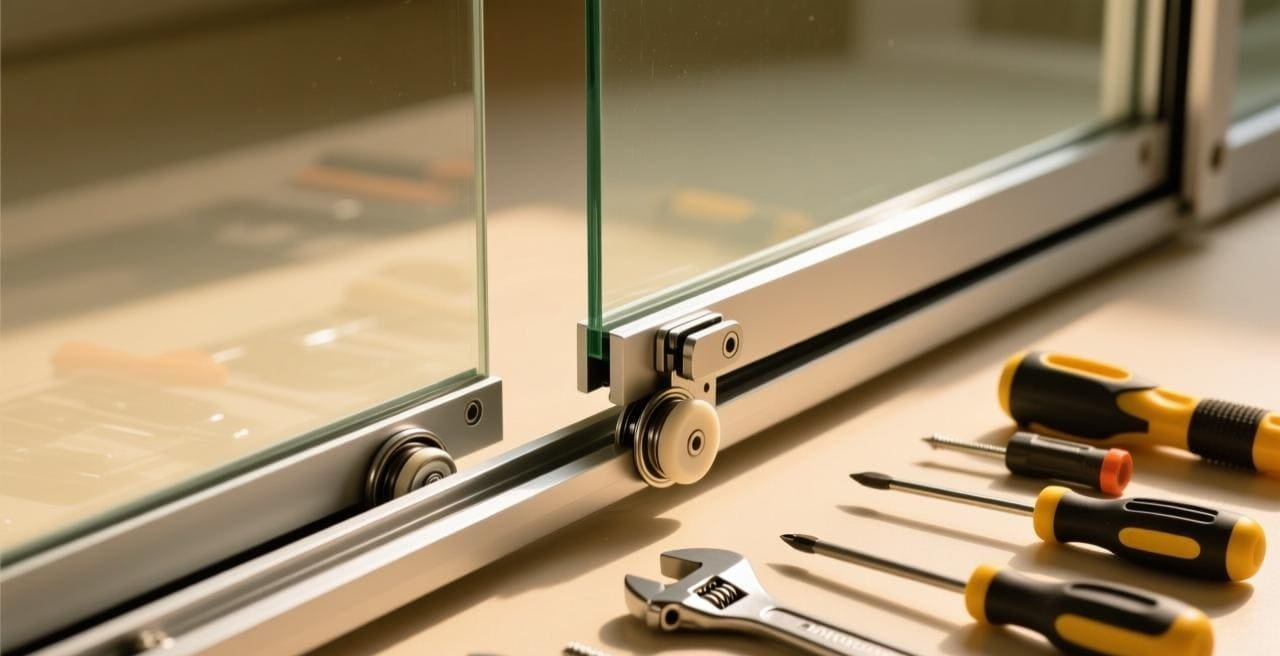
In my years of manufacturing door hardware, I’ve seen every possible issue. Customers like you, from door factories to contractors, need reliable solutions. It’s not just about a quick fix; it’s about understanding the root cause to prevent callbacks and maintain your reputation. Let’s dive into the specifics so you can diagnose and solve these problems effectively.
What is the common problem with sliding doors?
Frustrated by customer complaints about faulty sliding doors? A few common issues are usually the culprit. Understanding them is the first step to a permanent solution.
The most common problems are pulley derailment, where the wheel jumps the track; pulley damage, caused by excessive weight; and track deformation or obstruction, which prevents smooth movement. Each requires a specific approach to fix properly and ensure long-term reliability for your projects.
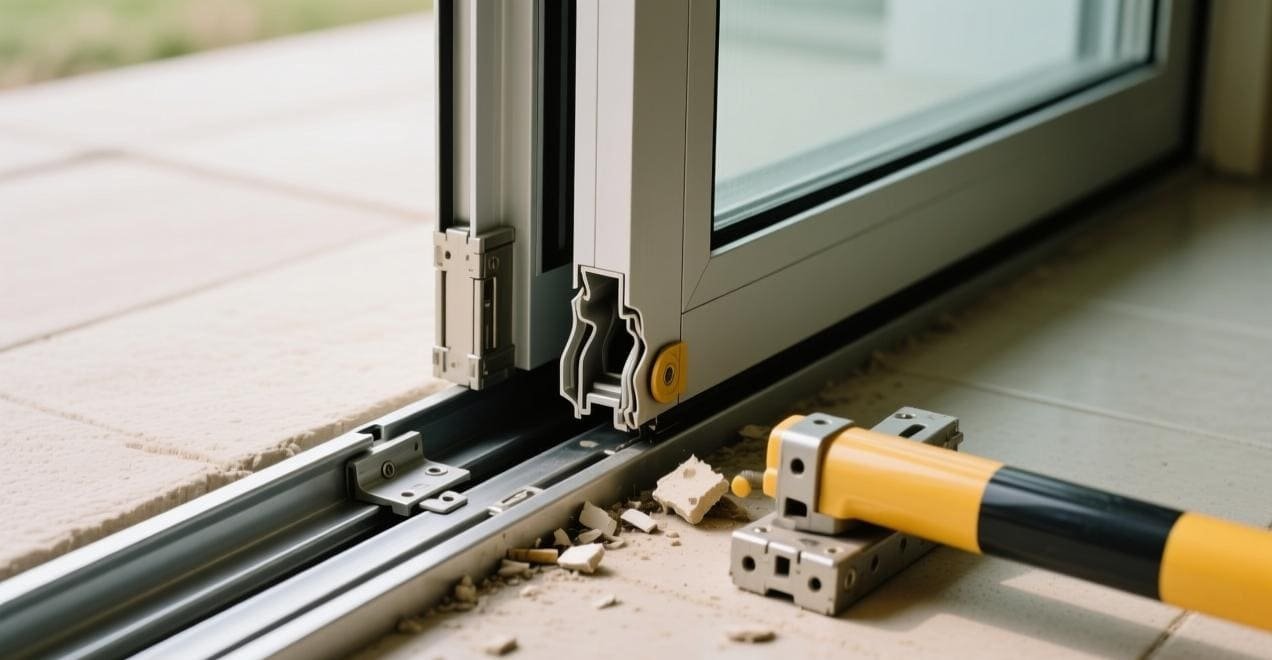
As a hardware supplier, I speak with purchasing managers like Jacky in Canada every day. They need to know that the components they source won’t lead to costly callbacks. The most frequent issues they face boil down to three things.
The Off-Track Annoyance: Pulley Derailment
This is when the pulley wheel comes off the track. The door becomes very hard to slide and often makes a scraping sound as the door frame grinds against the track. This can be caused by a sudden impact on the door or improper installation. For your customers, this is a major inconvenience. The quick fix is to lift the door and guide the pulley back into the track, but the real solution is ensuring the initial installation is perfect and the hardware is robust enough to handle daily use.
The Breaking Point: Pulley Damage
This happens when the pulley itself fails. I see this often when a door is too heavy for the specified hardware. The pulley can’t handle the gravity, causing it to deform, crack, or the internal bearings to seize up. The door will get stuck or make grinding noises. In this case, the only solution is to replace the pulley with one that has the correct weight rating. This is why it’s critical to match the hardware to the door’s specifications.
The Warped Path: Track Deformation1
If the pulleys seem fine but the door still sticks, the problem is likely the track. External force or using a track made from weak material can cause it to bend or deform. Debris inside the track can also block the pulley. This creates a spot where the door always gets stuck. The track needs to be cleaned, repaired, or, in severe cases, completely replaced.
| Problem | Primary Cause | Typical Symptom |
|---|---|---|
| Pulley Derailment | Improper installation, sudden impact | Door is hard to move, scraping sounds |
| Pulley Damage2 | Door weight exceeds pulley capacity | Grinding noise, door gets stuck, visible damage |
| Track Deformation1 | Heavy pressure, debris, poor material | Uneven movement, door jams at a specific spot |
How does a sliding door mechanism work?
Confused by the mechanics of a sliding door? It seems complex, but it’s actually quite simple. Knowing how it works helps you choose the right parts for your projects.
A sliding door mechanism uses rollers or pulleys fitted to the door, which run along a track installed at the top or bottom. This system transfers the door’s weight to the track, allowing it to glide horizontally with minimal effort, guided by the track’s path.
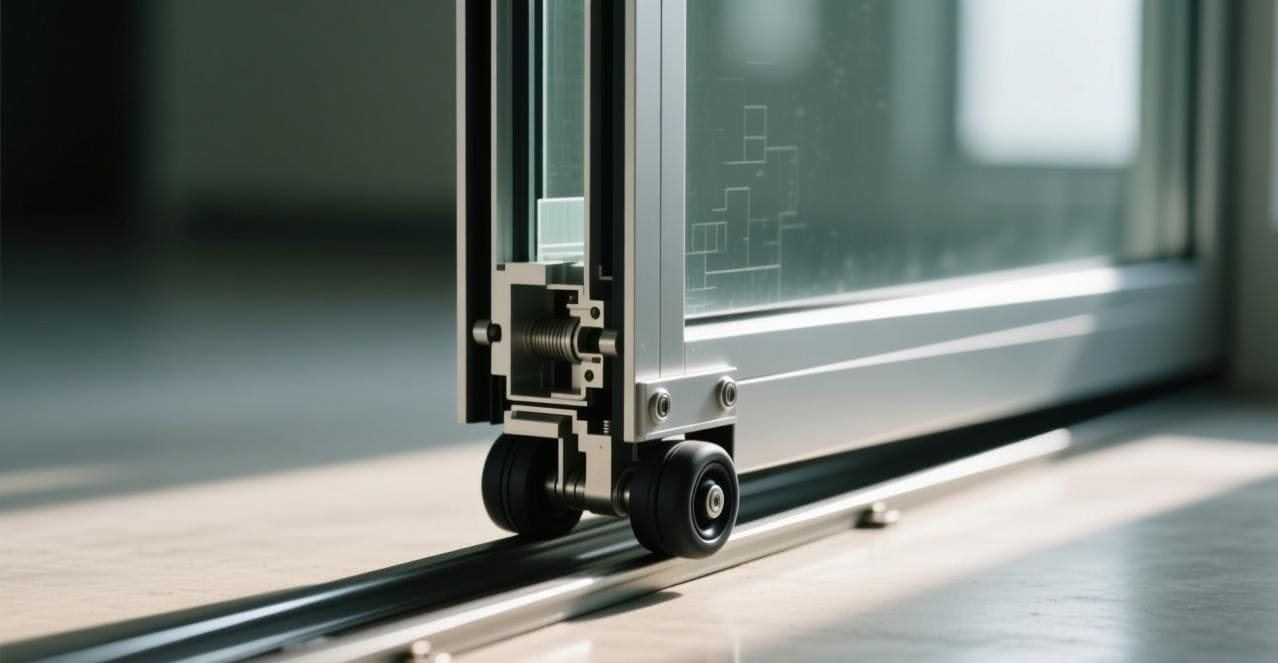
Understanding the basics is crucial for sourcing the right components. A simple sliding door system isn’t just one part, but a few key pieces working together. When one part is low quality, the entire system can fail.
The Key Components
The system has four main parts. First, the pulleys3 or rollers, which are the wheels that do the moving. Second is the track, the metal rail the pulleys3 run on. Third is the door panel itself. And fourth are the guides, which keep the door stable and prevent it from swinging. At our factory, we focus on making sure the pulleys3 and tracks are top quality, because they do all the heavy lifting. The quality of the bearings in the pulley, the material of the wheel, and the strength of the track determine how smoothly the door operates for years.
Top-Hung vs. Bottom-Rolling Systems
There are two main designs. A top-hung system4 suspends the door from a track above. A bottom-rolling system supports the door’s weight on a track below. Each has its place.
| System Type | Weight Support | Pros | Cons |
|---|---|---|---|
| Top-Hung | Upper track | Smooth, clean floor line | Requires strong header support |
| Bottom-Rolling | Bottom track | Easy installation, less structural need | Track can collect debris |
For high-end architectural projects, a top-hung system4 is often preferred because there’s no track on the floor to trip over. However, it requires a very strong wall or ceiling structure to support the door’s entire weight. A bottom-rolling system is more common in furniture and cabinets because it’s easier to install and doesn’t rely on structural support from above. As a purchaser, knowing the application helps you select the correct, most cost-effective system.
How to fix sliding door friction?
Is a dragging, friction-filled sliding door causing you headaches? This resistance is a sign of a problem. Here is how you can get it gliding smoothly again for your clients.
To fix sliding door friction, first clean the track and rollers of any dirt or debris. If friction persists, check for damage to the rollers or track deformation. Replacing worn-out rollers or straightening the track is often the necessary next step for a lasting solution.
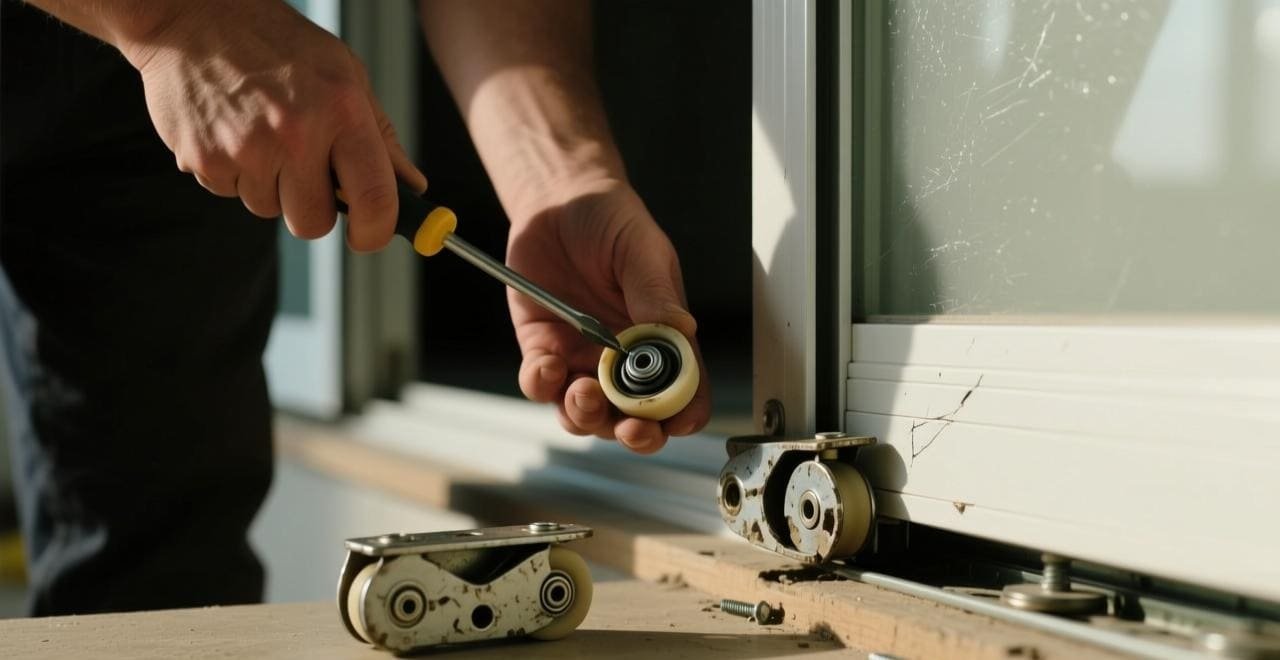
Friction is a clear signal that something is wrong with the sliding system. It doesn’t just make the door hard to use; it puts extra stress on all the components, leading to faster wear and tear. Here’s a simple process to diagnose and fix it.
Step 1: Clean the Path
The most common cause of friction is simple dirt and debris. Over time, dust, hair, and small particles build up in the track, especially in bottom-rolling systems. This buildup clogs the path of the rollers. The first step is always a thorough cleaning5. Use a stiff brush to loosen the debris and a vacuum cleaner to remove it. A damp cloth can wipe away any remaining grime. This simple maintenance step solves a surprising number of issues.
Step 2: Inspect the Rollers and Track
If cleaning5 doesn’t work, the next step is to look for damage. Take the door off the track to get a clear view of the rollers. Are the wheels cracked, chipped, or worn flat? Do they spin freely, or do they wobble or seize up? Worn-out rollers are a major source of friction. Next, inspect the track itself. Look for bends, dents, or warping. Run your finger along the track to feel for any rough spots. Any damage to these components will stop the door from gliding smoothly.
Step 3: Replace Worn Components
You can’t fix damaged parts. If the rollers are worn or the track is bent, they must be replaced. This is where sourcing quality hardware from the beginning pays off. High-quality pulleys with durable materials like nylon and sealed bearings resist wear far better than cheap alternatives. A strong aluminum or steel track will not bend under the door’s weight. By choosing the right components, you prevent friction issues from ever starting.
How to tighten up sliding doors?
Does your sliding door feel loose or wobbly in its track? This instability can be unsafe and annoying. You can easily tighten it up for a secure fit.
To tighten a sliding door, locate the adjustment screws on the side or face of the door’s roller assembly, usually at the top or bottom. Turning these screws raises or lowers that side of the door, allowing you to level it and ensure a snug fit in the track.
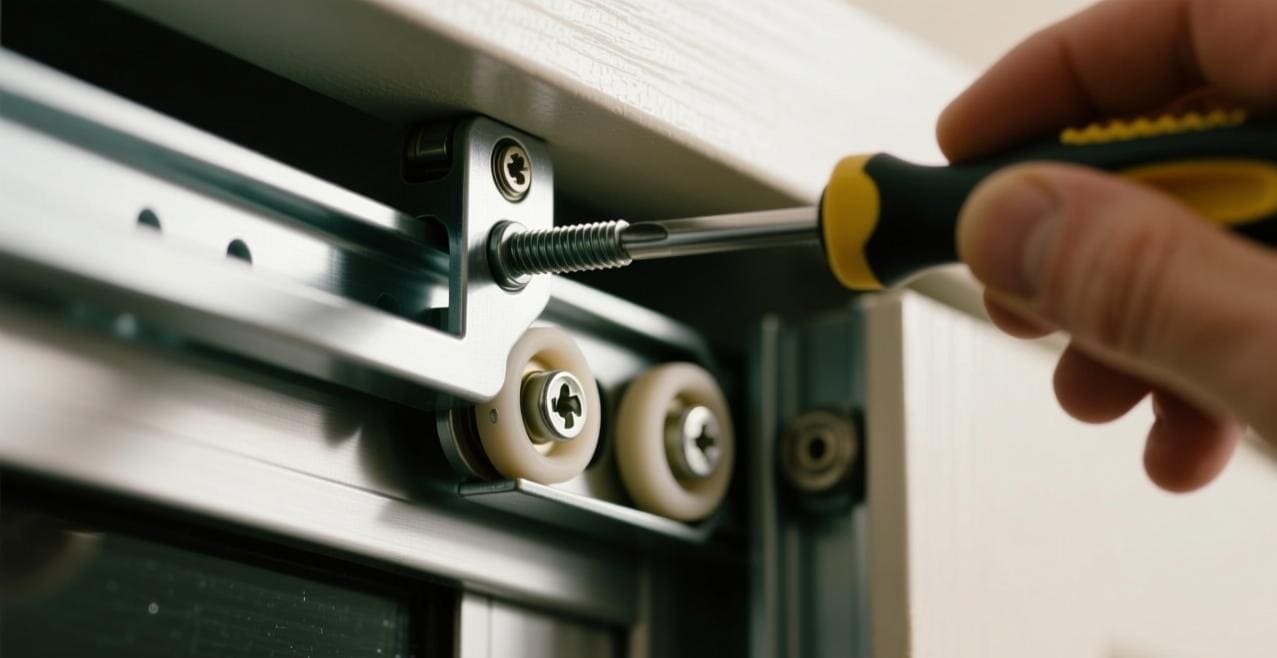
A wobbly door not only feels cheap but can also be a safety hazard. It can easily derail from its track, especially if closed with force. Fortunately, most modern sliding door systems are designed with simple adjustments to fix this. Making sure your installers know this process can save time and improve the final quality of the project.
Locating the Adjustment Screws
Almost every sliding door roller has an adjustment mechanism6. These are typically small screws. On many wardrobe or closet doors, you’ll find them on the visible face of the roller assembly at the top or bottom of the door. For heavier patio doors, they are often located on the side edge of the door, accessible through small holes. Turning the screw clockwise usually raises that corner of the door, while turning it counter-clockwise lowers it. This simple mechanism is key to a perfect fit.
The Adjustment Process
The goal is to make the door level and plumb7. Start by turning the screws on one side to raise or lower it until the gap between the door and the side jamb is even from top to bottom. Then do the same on the other side. You may need to go back and forth a few times to get it just right. This process ensures the door’s weight is distributed evenly on both rollers and that it sits squarely in the frame. A level door will glide more smoothly and seal properly, preventing drafts.
When Tightening Isn’t Enough
Adjustment can only do so much. If the door is still wobbly after you’ve leveled it, the problem is likely with the hardware itself. The rollers may be completely worn out, or the track might be too wide or damaged. In my experience, this is a common issue with low-cost hardware where tolerances are not precise. A well-designed roller and track system from a reliable factory like ours will have a snug fit from the start, making adjustment a fine-tuning process, not a repair job.
Conclusion
Solving sliding door issues is about correct diagnosis and using quality hardware. Clean, adjust, and replace worn parts to ensure smooth, reliable operation for years to come.
Exploring Track Deformation will provide insights on maintenance and improving door performance. ↩ ↩
Understanding Pulley Damage can help you prevent costly repairs and ensure smooth door operation. ↩
Explore this link to understand different pulley types and their benefits for door systems, ensuring optimal performance. ↩ ↩ ↩
Discover the advantages of top-hung systems, which can enhance your architectural projects with their sleek design and functionality. ↩ ↩
Exploring effective cleaning methods can help maintain your door system, preventing issues and ensuring smooth operation. ↩ ↩
Understanding the adjustment mechanism can help you maintain your sliding doors effectively and ensure they function smoothly. ↩
Learning how to achieve a level and plumb door is crucial for proper installation and functionality, enhancing your home’s comfort. ↩

